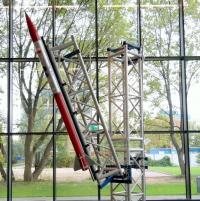CanSat Launcher Project
Students of WUT wish to organise the first CanSats competition in Poland. Young Engineers from the Students' Space Association (SKA) set themselves another ambitious goal ie. The Rocket Section of SKA wants to organize the first Polish competition of experiments with CanSats (satellites as little as 0,33l can). The competition will be addressed to people of all ages who are passionate about science and it will enable doing lots of interesting experiments in the atmosphere. It would be a novelty in Poland as currently, such competitions are only organized in the US and Western Europe.
Experiments the size of a can of soda
In CanSat competitions, it's required to fit inside of a soda can (66mm diameter and 115mm height) and have a mass below 350g. Antennas can be mounted externally, but the diameter can't increase until the CanSat has left the launch vehicle. The CanSats are deployed from small rocket at height which varies depending on the competition. CanSats are equipped with a recovery system, usually a parachute, to limit damage upon recovery and to allow the CanSat to be reused. CanSats are used to teach space technology, because of their inexpensive price and small volume.
The low cost of implementation, short preparation time and simplicity of design compared to other space projects make of this concept an excellent practical opportunity for students to take their first steps in space. Students are responsible for choosing the way the mission is fulfilled, the CanSat design, components integration, correct operation verification, launch preparation, data analysis and team organisation by distributing the workload. It is basically a scale replica of the design, creation and launch of a real satellite. The process required to develop a CanSat entails a learning process known as problem-based learning, a new teaching method in which the student is the main character and the one who must solve the problems. The main characteristic of this type of project is being carried out by teams facing open problems driven by successive challenges. The support given by teachers is declining in keeping with the experience the group is reaching to recognize that systems engineering also has to deal with the complexity of development and research of their own abilities. Space engineering discipline is one of the most typical methods used in education because it provides a wide range of attractive themes.
- CanSatLauncher will be characterised by g-force on the average level of 10G. It is lower than in the European Space Agency competition which will enable to increase the number of its participants. It will also lower the cost of making the CanSats - says Dawid Cieśliński – the Coordinator of the Rocket Section in SKA.
CanSat Launcher Rocket
Students will build the rocket with experiments on board by themselves. The Rocket Section at WUT has already got experience in rocket building as they have constructed and launched three rockets already: Amelia1, Amelia2 & H1.
Before starting this new project, the students have studied and analyzed solutions applied in the already existing rockets. Such constructions usually take up to six experiments and release them not higher than 3km. above the ground (usually 1- 1,5km).
- This new rocket is supposed to be 2,5m long, minimum 17cm. wide and its mass is not supposed to exceed 25kg. We are planning that its minimal ceiling will be 3km. Retrieving the rocket will be enabled by a parachute – We are estimating that the rocket will be falling not faster than 10 m/s – says one of the constructors of the rocket Mr. Tadeusz Górnicki. Students are planning to put eight CanSats on two levels – four experiments on each level.
Plans
Currently, they are designing a new engine for the rocket, one that would meet the requirements of the whole construction regarding the g-force and the minimal ceiling. It will most certainly be similar to the previous construction to its predecessors – the composite engines in Amelia2 and H1 rockets.
The young engineers want to build the engine and test it in chassis dynamometer before the end of this year. Concurrently with the works on the engine, students plan to make tests of launching CanSats from an especially designed platform. The plan is to build the rocket at the beginning of 2016 and to launch it for the first time without the experiments later on in the year. The first edition of our own CanSat competition should be announced at the beginning of 2017.
Good idea is already part of the success
- In July this year, the CanSat Launcher gained a support from Raytheon company from the US. This grant will enable students to build a rocket for making various tests. It will certainly bring us closer to organizing the first Polish CanSat competition. We would like to invite other companies to cooperation in this project – says Dawid Cieśliński, the Coordinator of WUT’s Students' Space Association (SKA).








